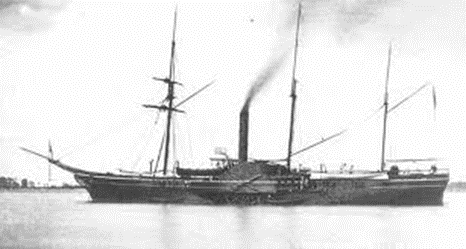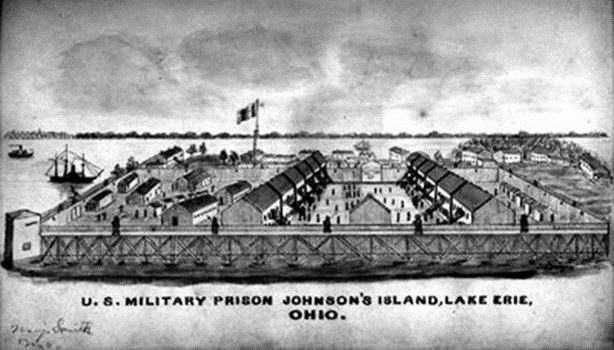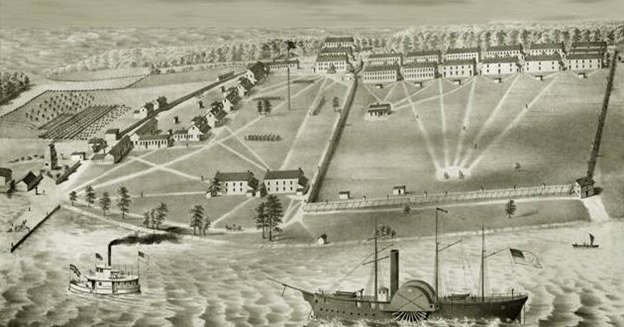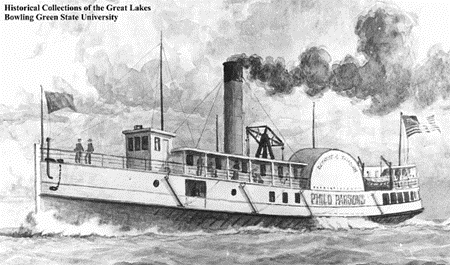
The USS Paddle Frigate Michigan, the first iron-hulled ship in the U.S. Navy. Built in parts in Pittsburgh and assembled in Erie, she was launched in 1843 and commissioned in 1845. Her role was to be America’s only armed warship on the Great Lakes. Negotiations with Britain after the War of 1812 stipulated that each country was to have just one armed ship on the lakes. While her armament changed many times at the whim of events and politics, Michigan remained a fixture in Erie and the western lakes for her entire career. Her home port was Erie, and so many sailors married Erie girls, the city took on the nickname “mother-in-law of the Navy.”
When the Civil War began in 1861, Michigan would continue as the visible representative of the United States government. Her main duty, to rescue stranded ships and victims of shipwrecks, would continue, but the war brought fear and danger to the Great Lakes region. Britain had not sided with the United States, and there was a great deal of trade flowing through Canada and across the lakes, heading for the Confederacy. Rumors of Confederate raids launched from Canada were rampant. The fear of ships manned with Confederates coming via the lakes from Canada turned out not to be just a fear but a reality.
In addition to the fear of raids across the lake, 1863 saw the United States begin conscription or the draft to fill the dwindling Union armies. Draft riots broke out in many major Northern cities like New York, and more important to Michigan and her crew Detroit, Buffalo and Milwaukee. The USS Michigan commanded by Commander John Carter sailed to these cities and often placed herself near government warehouses or in a position to fire at rioters. He armaments saw a wartime increase to fifteen cannons or “guns” of varied sizes and types.

In Sandusky Bay at Sandusky, Ohio, the United States Army had established a prisoner of war camp, originally for Confederate officers. Designed to house roughly 2,500 men, Johnson’s Island would contain upwards of 15.000 prisoners of all ranks as well as spies, guerrillas and political prisoners. Michigan would also have to guard Johnson’s Island in addition to her regular duties. It turned out to be fortuitous because the Confederates were up to something, and Michigan would play a role.

In September 1864, the Confederate plan went into action on western Lake Erie. The plan called for a group of about fifty-four men and lead by Confederate Captains Charles Cole and John Yates Beall, take the prison camp at Johnson’s Island and capture the civilian passenger steamer Philo Parsons, sail alongside Michigan, and seize her. The rebel leaders believed that Michigan’s capture would so demoralize the soldiers of the 128th Ohio, the prison camp’s guards, that the regiment would surrender, (10 Confederates had managed to enlist in the 128th). Once the prisoners from Johnson’s Island had been freed, the force would march to Columbus, Ohio and free Confederate prisoners being held at Camp Chase. The combined force would then march throughout Ohio, causing Union forces fighting in the south to be sent away from the front to put down the threat of freed Confederate prisoners in Ohio, allowing the main southern armies to go on the offensive in Virginia, Kentucky and Tennessee.

On September 19, the Confederate force under John Beall captured Philo Parsons after rebel agents boarded her in twos and threes at her various regular stops that day. They steamed toward Sandusky after a brief encounter with another civilian steamer Island Queen, full of off-duty Union soldiers of the 130th Ohio. They captured Island Queen but decided to scuttle her and strand the crew and soldiers on Middle Bass Island rather than waste men to guard them. Beall was not sure if Cole’s part of the plan-to capture Michigan had taken place, so he anchored in Sandusky Bay that night to wait for signal.
Cole had become friendly with prominent citizens in Sandusky and, apparently with some of Michigan’s officers, and arranged to hold a dinner for the ship’s officers on September 20, 1864. He planned to drug the officers or get them drunk and take over the ship. Unfortunately for him, an officer from Johnson’s Island arrived aboard Michigan with a warrant for Cole’s arrest as a spy. Without a signal from Cole, Beall steamed Philo Parsons north to Sandwich, Ontario, where they scuttled the ship at the dock, and most of the crew attempted to disappear into Canada, except for two men who were still present at the ship when British authorities arrived, including Beall’s second in command Bennett G. Burley.
In the wake of the plot, Cole would spend the rest of the war in prison, and Beall was executed as a spy in February 1865. The two forts on Johnson’s Island, Ft. Johnson and Ft. Hill, were improved for defense, and Michigan stepped up her role in preventing further Confederate planned raids into the United States.
